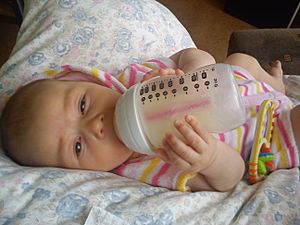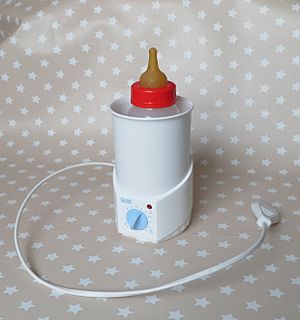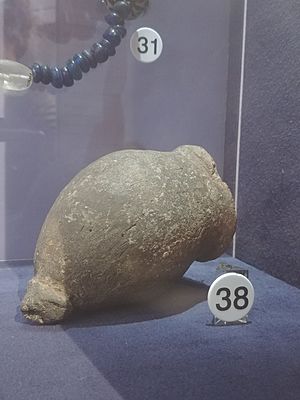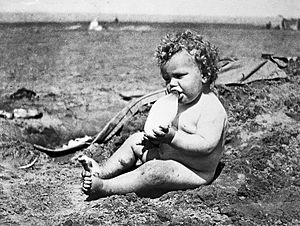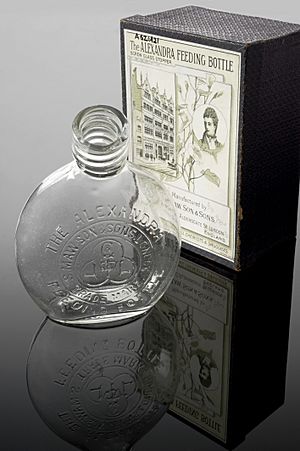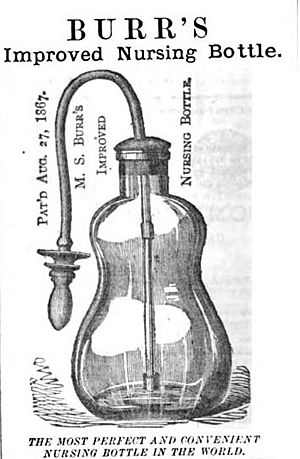Baby bottle facts for kids
A baby bottle is a special bottle with a soft top called a teat (or nipple in the US). Babies and young children use it to drink milk or other liquids. It's also used to feed young animals.
Most baby bottles are made from hard plastic. Plastic is light, clear, and doesn't break easily. Some bottles are made of glass. Glass bottles are easy to clean and don't hold onto smells or chemicals. There are also bottles made from stainless steel or silicone rubber.
Baby bottles can hold human milk, special baby formula, or rehydration drinks. When babies drink from a bottle, their tongue and jaw move in a similar way to breastfeeding. They can create suction to get the milk out.
It's important to clean and sterilize bottles properly. This helps stop germs from growing and keeps babies healthy.
Contents
Bottle Design and Materials

A typical baby bottle has four main parts. First, there's the bottle itself, which holds the liquid. Second, the teat or nipple is the soft part the baby sucks on. It has a small hole for milk to flow through. Third, the collar screws onto the bottle, holding the teat in place. Finally, a cap covers the teat to keep it clean and prevent spills. Some bottles also have disposable liners inside.
Designers create baby bottles with safety and comfort in mind. A safe bottle should not break easily. It should not have small parts that could come off. The materials used must be safe for health. And it must be easy to clean to prevent germs.
Bottles should also be comfortable for both the baby and the person feeding them. Lightweight bottles that are easy to hold are popular. Different shapes are available. Designers also try to control how fast the milk flows. This helps babies get enough food without drinking too much too quickly.
Materials Used for Bottles
Over time, many different materials have been used for baby bottles. Today, the most common materials are glass and certain types of plastics. Food-grade stainless steel and silicone rubber are also used. Each material has its good and bad points. Teats are usually made from latex rubber or silicone.
Glass and stainless steel are very stable materials. They don't react much with the milk inside. Glass bottles can be heavy and might break if dropped. Stainless steel bottles are strong but you can't see how much liquid is left.
Plastics are light and don't break easily. They can be shaped in many ways. However, some plastics might react with liquids like milk. Certain chemicals, like Bisphenol A (BPA), used to be in some plastics. These chemicals could "leak" into the milk. Because of safety worries, many countries have banned BPA in baby bottles.
Other chemicals, like Bisphenol S (BPS) and Bisphenol F (BPF), have been used instead of BPA. Scientists are still studying these to make sure they are safe. Some plastics, like polypropylene, have been found to release tiny plastic pieces called microplastics. This happens more when liquids are warm. To reduce this, some experts suggest using bottles made of glass, silicone, or stainless steel.
Baby bottle teats are usually made from silicone or latex rubber. Silicone teats are clear, strong, and a bit firmer. Latex rubber teats are stretchy, soft, and don't tear easily. Latex can absorb smells, but silicone does not. Some people are allergic to latex.
Bottle Size and Shape
Bottles come in standard sizes, often around 120 ml (4 US oz) and 240 ml (8 US oz). Smaller bottles are lighter and easier for young babies to hold. Some worry that larger bottles might encourage overfeeding.
Bottles are usually tall and narrow. This helps make sure the teat stays full of liquid when the baby drinks. If a bottle is too tall, it can tip over easily. Some bottles have special shapes to help prevent this.
The shape of a bottle also affects how easy it is to clean. Some designs try to look more natural. Other shapes are made to help milk warm up or cool down faster. This saves time and helps keep the milk fresh.
"Anti-colic" bottles are designed to reduce gas and discomfort for babies. These bottles try to stop babies from swallowing too much air while feeding. Some designs also prevent air from mixing with the milk inside the bottle. At the same time, they need to stop a vacuum from forming, which would make it hard for the baby to drink. These designs often use special shapes or "vents."
Some vented bottles or bottles with collapsible liners work well. They help babies drink milk without taking in too much air. Studies have shown these bottles don't affect how much milk a baby drinks or their breathing patterns.
Teat Flow Rate
The design of the teat can affect how a baby sucks and how much milk they drink. The "flow rate" is how fast milk comes out of the nipple. The shape of the nipple and the size of its hole can change this.
It's hard for parents to choose the right teat because there's no standard way to label flow rates. A nipple labeled "Slow" might have a very different flow rate from another brand's "Slow" nipple. This can be a problem, especially for babies who have trouble feeding.
Bottle Accessories
Many accessories are available for baby bottles. Bottle brushes are used for cleaning. Sterilizers use different methods like ultraviolet light, boiling water, or hot steam to kill germs. Drying racks help bottles air dry.
Bottle warmers heat up refrigerated formula. Coolers keep formula cold when you're out. Special containers store pre-measured formula powder. This makes it easy to mix formula on the go.
Some hospitals use ready-to-feed formula in containers that become bottles. You just screw off the lid and put on a disposable teat.
Using Baby Bottles Safely
Cleaning and Sterilization
Sterilization is very important to stop germs from growing and making babies sick. It's more effective than just washing. Many health groups recommend sterilizing all parts of a baby bottle. This includes the bottle, teat, and screw caps.
Methods for sterilizing include using cold water solutions, steam sterilizers, or boiling water. In places with clean water and good sanitation, washing bottles with soap and water or in a dishwasher might be enough. However, germs like E. coli can form sticky layers (biofilms) inside bottles. Simple rinsing isn't enough to remove them.
In areas where water quality isn't as good, the risk of infection is higher. Studies have shown that bottles thought to be clean can still have germs. It's important for parents to understand and follow cleaning instructions carefully. For example, boiling bottles for the right amount of time is crucial.
When to Stop Using Bottles
Health experts recommend introducing a sippy cup or beaker to babies around 6 months old. Most suggest stopping bottle use by 1 year of age. The AAP says bottles should be stopped by 18 months.
Using bottles for too long, especially past two years of age, can lead to tooth decay.
Bottle Regulations
While baby formula is strictly controlled in many countries, baby bottles are not always as regulated. Some countries have rules about the materials used for the teat and bottle. For example, in the USA, the Food and Drug Administration (FDA) regulates these materials.
One chemical that has been regulated is Bisphenol A (BPA). Scientists found that BPA could act like hormones in the body. This led to worries about its safety. Many countries, including all EU countries, Canada, and the USA, have banned BPA in baby bottles. This happened after research and public pressure.
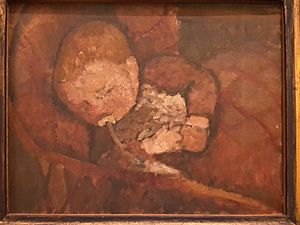
History of Baby Bottles
For most of history, babies were fed by their mothers or a wet nurse. But people also looked for other ways to feed children. As early as 1500 BCE, ancient Egyptian art shows women using animal horns to feed babies.
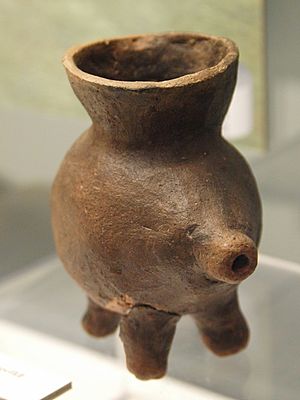
Ancient containers with hard spouts have been found by archaeologists. These early feeding vessels had one opening for filling and another for the baby to suck from. Scientists have found traces of animal milk in some of these old ceramic bottles from as far back as 1200 BCE.
Around 250-300 BCE, the Egyptians learned to blow glass. The Romans made clear glass feeding bottles, but these didn't become widely popular. Leather and wood were also used for feeding tools. By the 1700s, feeding cups and pots were made from materials like pewter, tin, and silver.
In the 1800s, changes in society and technology led to more artificial feeding. More mothers worked outside the home. New bottle designs and milk substitutes became available. However, understanding of nutrition and cleanliness was still poor. This led to very high infant death rates during the Victorian era.
The first glass nursing bottle in the United States was patented in 1841. By the late 1800s, many different glass bottles were made. The US Patent Office issued over 200 patents for nursing bottle designs by the 1940s.
The design of baby bottles, especially how easy they were to clean, greatly affected babies' health. Some bottles had long rubber tubes that were almost impossible to keep clean. These were sometimes called "murder bottles" because they spread so many germs.
In 1894, a new "banana" shaped bottle was introduced. It had a removable valve and teat on both ends, making it much easier to clean. This "hygienic bottle" helped improve survival rates. Similar bottles were popular until the 1950s. As people learned more about germs and public health, infant deaths decreased.
Heat-resistant Pyrex bottles were introduced in the US in 1922. They came in different shapes and sizes. In the 1950s, an upright Pyrex bottle with a narrow neck became popular. Later, a wide-neck version made cleaning and sterilizing even easier.
Soft nipples made of various materials were used early on. But they were hard to clean and could be dangerous. The invention of rubber in the 1840s provided a soft material. By the early 1900s, better rubber nipples were made that could handle heat for sterilization.
In the 1940s, nurse Adda M. Allen patented the first disposable collapsible liner for a baby bottle. This design aimed to reduce babies swallowing air and getting upset stomachs. A plastic bottle with a disposable liner was later sold by Playtex.
Modern baby bottles often include features like a special valve in the nipple. This valve helps liquid flow in one direction and prevents a vacuum from forming. This technology is now used in many drinking products.
Today, the baby bottle market is a huge business worldwide.
See also
 In Spanish: Biberón para niños
In Spanish: Biberón para niños


